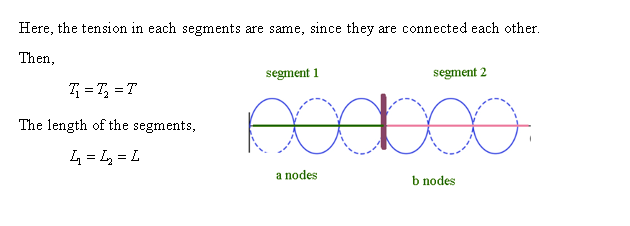You have two string segments of equal length. Segment 1 has linear mass density μ₁and segment 2 has linear mass density μ₂. You splice the two together and then tie the combination tautly between two posts. You've spliced in such a way that, once attached to the posts, the length of segment 1 to the left of the splice is the same as the length of segment 2 to the right of the splice. When you pluck at a particular frequency you set up a standing wave that has this pattern: nodes at the splice and where each segment is attached to its pole, plus a more nodes in
You have two string segments of equal length. Segment 1 has linear mass density μ₁and segment 2 has linear mass density μ₂. You splice the two together and then tie the combination tautly between two posts. You've spliced in such a way that, once attached to the posts, the length of segment 1 to the left of the splice is the same as the length of segment 2 to the right of the splice. When you pluck at a particular frequency you set up a standing wave that has this pattern: nodes at the splice and where each segment is attached to its pole, plus a more nodes in
Related questions
Question
Note: You do not get to decide numbers for a and b. Treat letters a and b as a stand in for unknown/unspecified number.

Transcribed Image Text:You have two string segments of equal length. Segment 1 has linear mass density
μ₁and segment 2 has linear mass density μ₂. You splice the two together and then
tie the combination tautly between two posts. You've spliced in such a way that,
once attached to the posts, the length of segment 1 to the left of the splice is the
same as the length of segment 2 to the right of the splice. When you pluck at a
particular frequency you set up a standing wave that has this pattern: nodes at
the splice and where each segment is attached to its pole, plus a more nodes in
segment 1 and b more nodes in segment 2.
What is the numerical value of 1?
H₂
Expert Solution
Step 1

Trending now
This is a popular solution!
Step by step
Solved in 2 steps with 2 images
